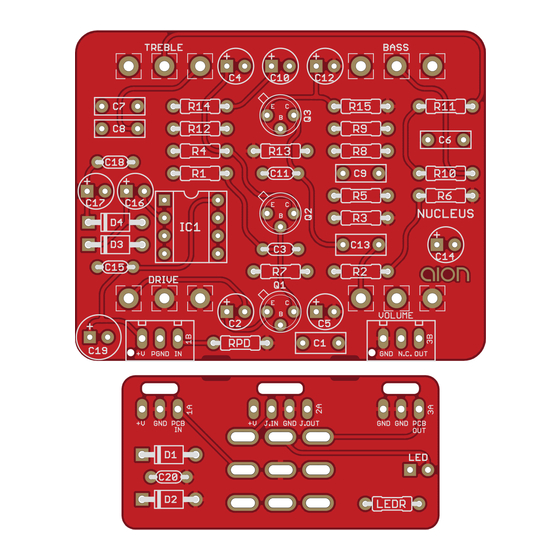Table of Contents
Advertisement
Quick Links
Rift
Based on the Univox Superfuzz
Overview
Controls & Usage
The controls for the Superfuzz are pretty standard:
• Expander controls the fuzz level of the effect. (This acts as a volume control after a fixed-level input
boost stage, very similar to the Sustain knob on a
• Volume controls the overall output level.
• Tone allows you to switch between two fixed tone sections, one with a mid-scoop and another with a
flatter and less aggressive sound. This can be wired as a pot instead of a switch, allowing you to fade
between the two settings.
• Clip allows you to select a different set of diodes or lift the diodes altogether.
Modifications & Experimentation
If you want to use a tone pot instead of the switch, you'll find it convenient that the pot fits in the exact same
pads and you just need to drill the enclosure differently. This allows for blending between the two fixed tone
settings, which makes it a much more flexible control.
The clipping switch lets you choose from two sets of diodes. The stock unit uses germanium, around 0.3V
forward voltage, but lots more sounds can be had by using different diodes with a higher clipping threshold, or
by removing the diodes entirely in the center position. For the second set of diodes, I recommend using two
1N914s in series, but you should socket them and experiment.
Expect to make significant volume adjustments when switching between the different clipping diode options.
This circuit uses hard clipping by way of anti-parallel diodes going to ground. As a result, the volume level is
directly affected by the total clipping threshold (forward voltage) of the diodes being used.
RIFT (BASED ON THE UNIVOX SUPERFUZZ)
The Rift is a modified version of the Univox Superfuzz, a
classic octave fuzz. It was originally developed by the Shin-
Ei company in Japan and called the FY-6, but they also
rebadged the circuit for over a dozen other brands such as
Apollo, Electra and Hohner. However, the Univox Superfuzz
was the most well-known of the brands and is considered
the definitive version of the circuit.
The Rift includes two modifications that lend more flexibility
to this circuit. While the original unit only had a tone switch
to go between two presets, here you have the option of
using a pot instead to blend between them. There is also a
clipping switch to allow you to choose between two different
sets of diodes, or lift them altogether for a different (and
much louder) sound.
Big
Muff.)
Rift Project Link
1
Advertisement
Table of Contents

Summary of Contents for Aion Electronics Rift
- Page 1 Based on the Univox Superfuzz Overview Rift Project Link The Rift is a modified version of the Univox Superfuzz, a classic octave fuzz. It was originally developed by the Shin- Ei company in Japan and called the FY-6, but they also rebadged the circuit for over a dozen other brands such as Apollo, Electra and Hohner.
- Page 2 Small Bear to insulate the back of the pots from the board and prevent shorts. If you don’t use these, use some electrical tape or cardboard to act as insulation. The right-angle pots will make direct contact with the solder pads otherwise. RIFT (BASED ON THE UNIVOX SUPERFUZZ)
- Page 3 Q4 and Q5 and then use the octave trimmer to fine-tune the effect. Important note: The Rift PCB layout uses the USA-standard E-B-C pinout (2N3904, 2N5088, etc.) for the transistors. If you do use a vintage transistor like the 2SC828 or 2SC945, make sure to adjust accordingly.
- Page 4 Schematic RIFT (BASED ON THE UNIVOX SUPERFUZZ)
- Page 5 General Build Instructions These are general guidelines and explanations for all Aion Electronics DIY projects, so be aware that not everything described below may apply to this particular project. Build Order When putting together the PCB, it’s recommended that you do not yet solder any of the enclosure-mounted control components (pots and switches) to the board.
- Page 6 Hammond 1590B (bottom/inside view) EXPANDER VOLUME CLIP TONE (SW) TONE (POT) Parts Used • Switchcraft 111X enclosed jacks • Kobiconn-style DC jack with internal nut RIFT (BASED ON THE UNIVOX SUPERFUZZ)
- Page 7 (In other words: you don’t have to go out of your way to advertise the fact that you use these PCBs, but please don’t go out of your way to hide it. The guitar effects pedal industry needs more transparency, not less!) RIFT (BASED ON THE UNIVOX SUPERFUZZ)
















Need help?
Do you have a question about the Rift and is the answer not in the manual?
Questions and answers